
A water tower is an elevated building supporting a water tank constructed at a height sufficient to pressurize a water distribution system for the distribution of potable water, and to provide emergency storage for fire protection. Water towers often operate in conjunction with underground or surface service reservoirs, which store treated water close to where it will be used. Other types of water towers may only store raw (non-potable) water for fire protection or industrial purposes, and may not necessarily be connected to a public water supply.
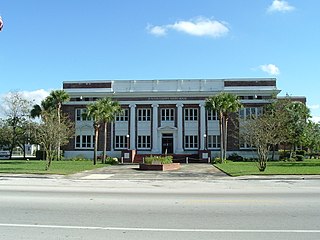
Bunnell is the county seat of Flagler County Florida, United States, with a population of 2,676 at the 2010 census. The city is part of the Deltona–Daytona Beach–Ormond Beach, FL metropolitan statistical area and is named after an early resident, Alvah A. Bunnell, a shingle maker and supplier of wood to the area's fledgling rail industry.

Birdsill Holly Jr. was an American mechanical engineer and inventor of water hydraulics devices. He is known for inventing mechanical devices that improved city water systems and patented an improved fire hydrant that is similar to those used currently for firefighting. Holly was a co-inventor of the Silsby steam fire engine. He founded the Holly Manufacturing Company that developed into the larger Holly Steam Combination Company that distributed heat from a central station and developed commercial district heating for cities in the United States and Canada.
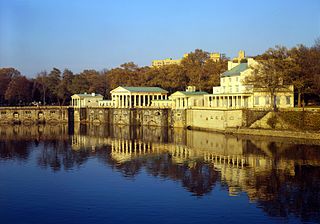
The Fairmount Water Works in Philadelphia, Pennsylvania was Philadelphia's second municipal waterworks. Designed in 1812 by Frederick Graff and built between 1812 and 1872, it operated until 1909, winning praise for its design and becoming a popular tourist attraction. It now houses a restaurant and an interpretive center that explains the waterworks' purpose and local watershed history. It was designated a National Historic Landmark in 1976 for its architecture and its engineering innovations. It was the nation's first water supply to use paddle wheels to move water.
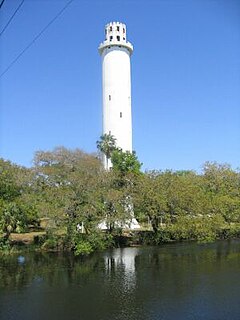
Sulphur Springs Water Tower is a landmark of Tampa, Florida. It stands 214 feet (65 m) tall, with a foundation 45 feet (14 m) deep which makes it visible from nearby Interstate 275 and much of the rest of Sulphur Springs. It's located in the historic district of Sulphur Springs.

Walka Water Works is a heritage-listed 19th-century pumping station at 55 Scobies Lane, Oakhampton Heights, City of Maitland, New South Wales, Australia. Originally built in 1887 to supply water to Newcastle and the lower Hunter Valley, it has since been restored and preserved and is part of Maitland City Council's Walka Recreation and Wildlife Reserve. It was added to the New South Wales State Heritage Register on 2 April 1999.
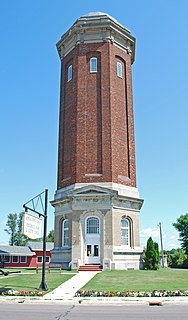
The Manistique Pumping Station is an industrial waterworks building located on Deer Street in Manistique, Michigan. It was listed on the National Register of Historic Places in 1981.

The Davenport Water Co. Pumping Station No. 2, also known as the Ripley Street Pumping Station No. 2, is located in central Davenport, Iowa, United States. It has been listed on the National Register of Historic Places since 1984. The historic building has subsequently been replaced in 1986 by a smaller plain structure on the same property facing West 14th Street.

The Benton Stone Water Tower is located in Benton, Wisconsin. It was added to the National Register of Historic Places in 1999.

The Evansville Standpipe is a historic water tower located in Evansville, Wisconsin. The 80-ft tall steel tower was built in 1901 by the Chicago Bridge & Iron Company, as part of the development of the local water supply system, spurred on by a devastating fire in 1896 that destroyed a large section of downtown Evansville. It was added to the National Register of Historic Places in 2008.

The City of Beloit Waterworks and Pump Station was built in 1885 in Beloit, Wisconsin just below a hill on top of which sits the Beloit Water Tower. It was added to the National Register of Historic Places in 1990.

The Yeoville Water Tower is located in Harley and Percy Streets, Yeoville, near the fountain of Doornfontein; it was built in 1914 by the Sivewright's Johannesburg Waterworks, Estate and Exploration company. It was constructed with a reservoir to supply piped water to Johannesburg.
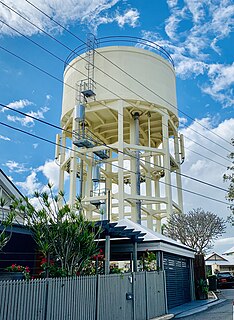
Paddington Water Tower is a heritage-listed water tower at 16 Garfield Drive, Paddington, City of Brisbane, Queensland, Australia. It was designed by Metropolitan Water Supply & Sewerage Board and built by day labour in 1927. It was added to the Queensland Heritage Register on 23 June 2000.

East Bundaberg Water Tower is a heritage-listed water tower at 17 Sussex Street, Bundaberg East, Bundaberg Region, Queensland, Australia. The tower is the only circular brick water-tower in Queensland and was designed by James Baillie Henderson and built from 1901 to 1902. It was added to the Queensland Heritage Register on 21 October 1992.

The Penshurst Reservoirs are heritage-listed reservoirs located at Laycock Road, Penshurst in the Georges River Council local government area of New South Wales, Australia. They were designed and built during 1895 by the NSW Public Works Department. The reservoirs are also known as WS87 & R88, Penshurst Elevated Steel Reservoir No 2 and Penshurst Elevated Concrete Reservoir No 3. The property is owned by Sydney Water, an agency of the Government of New South Wales. The site was added to the New South Wales State Heritage Register on 18 November 1999.
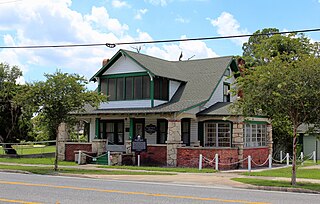
The Holden House, located at 204 E. Moody Blvd., Bunnell, Florida, was built in 1918 by Samuel Merwin Bortree (1859-1918) as a wedding gift for his daughter Ethel Lura Bortree Holden (1892-1977), and her husband Thomas Edward Holden (1892-1974). It is an excellent example of the Craftsman Bungalow architectural style. The house was purchased by Flagler County for $40,000 on August 6, 1979 from a Holden family member. It is now a museum that features artifacts from Flagler County and the general Florida area dating from the St. Johns Culture to the present. It is also the headquarters for the Flagler County Historical Society. The house's upstairs bathroom was one of the first indoor bathrooms in the Bunnell area and features unique small hexagon tiles on the floor which were similar to the flooring design used in the original owner's pharmacy building which is no longer extant and was located at the southwest corner of the intersection of Moody Boulevard and U.S. 1 in Bunnell. The Holden House was listed on the National Register of Historic Places on October 16, 2018.

The Bunnell Coquina City Hall is a unique one-story public building constructed of locally quarried coquina stone. The property is located at 200 South Church Street, Bunnell, FL 32110 in the downtown section of the city. It includes man-made Lake Lucille with its jetting fountain in the front of the building, which creates an impressive visual appeal to the setting of the property. It was built in 1936–1937 with grant funding from the Work Progress Administration WPA.

During the 1930s, the Flagler County, Florida Jail was in dire need of repairs and enlargement. Flagler County Commissioners were under pressure from local citizens and grand juries to repair the building or erect a new one. After months of negotiations, during 1938, between the Flagler County Board of Commissioners and the Works Progress Administration WPA an agreement to build a new Flagler County Jail building was approved. A WPA Project, No. 4242, was approved that cost approximately $24,000. It was agreed that the costs would be divided between Flagler County and the WPA. Construction of the new Flagler County Jail started January 25, 1939 under the management of Z. D. Holland, WPA Supervisor and well known local contractor. It was built on 2.04 acres of county-owned property located at 1600 Old Moody Blvd., Bunnell, FL.

A water distribution system is a part of water supply network with components that carry potable water from a centralized treatment plant or wells to water consumers in order to adequately deliver water to satisfy residential, commercial, industrial and fire fighting requirements.

The Espanola Schoolhouse is a one-story; one-room rural school building that has survived from the Jim Crow racial segregation-era. It is the last standing one-room schoolhouse in Flagler County. It is located at 98 Knox Jones Avenue, Bunnell, Florida 32110.


























